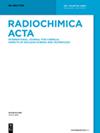开发用于胰腺癌正电子发射断层扫描诊断的明胶纳米粒子
IF 1.7
3区 化学
Q4 CHEMISTRY, INORGANIC & NUCLEAR
引用次数: 0
摘要
使用现有的成像探针仍然难以诊断胰腺癌。因此,本研究旨在开发一种新型成像剂,利用正电子发射断层扫描(PET)诊断胰腺癌。具体来说,本研究探讨了通过辐射诱导交联制造的明胶基纳米粒子,因为明胶以其制造生物相容性材料的能力而闻名。用 γ 射线照射明胶水溶液,通过辐射交联技术生成平均直径为 5-20 纳米的纳米颗粒。明胶纳米粒子被标记为 64Cu,呈现负表面电位。此外,还将纳米颗粒注射到胰腺肿瘤小鼠体内,对其进行了体内评估。值得注意的是,纳米粒子在肿瘤内积聚。因此,64Cu 标记的明胶纳米颗粒有望成为下一代胰腺癌 PET 成像剂的平台。本文章由计算机程序翻译,如有差异,请以英文原文为准。
Development of gelatin nanoparticles for positron emission tomography diagnosis in pancreatic cancer
Pancreatic cancer remains difficult to diagnose using currently available imaging probes. Thus, this study aimed to develop a novel imaging agent for the diagnosis of pancreatic cancer using positron emission tomography (PET). Specifically, this study explores gelatin-based nanoparticles fabricated via radiation-induced crosslinking, as gelatin is known for its ability to produce biocompatible materials. Aqueous gelatin solutions were irradiated with γ-rays to produce nanoparticles with average diameters of 5–20 nm via a radiation crosslinking technique. The gelatin nanoparticles were labeled with 64 Cu, exhibiting negative surface potentials. Furthermore, the nanoparticles were evaluated in vivo by injecting them into pancreatic tumor-bearing mice. Notably, the nanoparticles accumulated in the tumors. Hence, 64 Cu-labeled gelatin nanoparticles show promise as a platform for next-generation PET imaging agents for pancreatic cancer.
求助全文
通过发布文献求助,成功后即可免费获取论文全文。
去求助
来源期刊

Radiochimica Acta
化学-核科学技术
CiteScore
2.90
自引率
16.70%
发文量
78
审稿时长
6 months
期刊介绍:
Radiochimica Acta publishes manuscripts encompassing chemical aspects of nuclear science and technology.
 求助内容:
求助内容: 应助结果提醒方式:
应助结果提醒方式:


